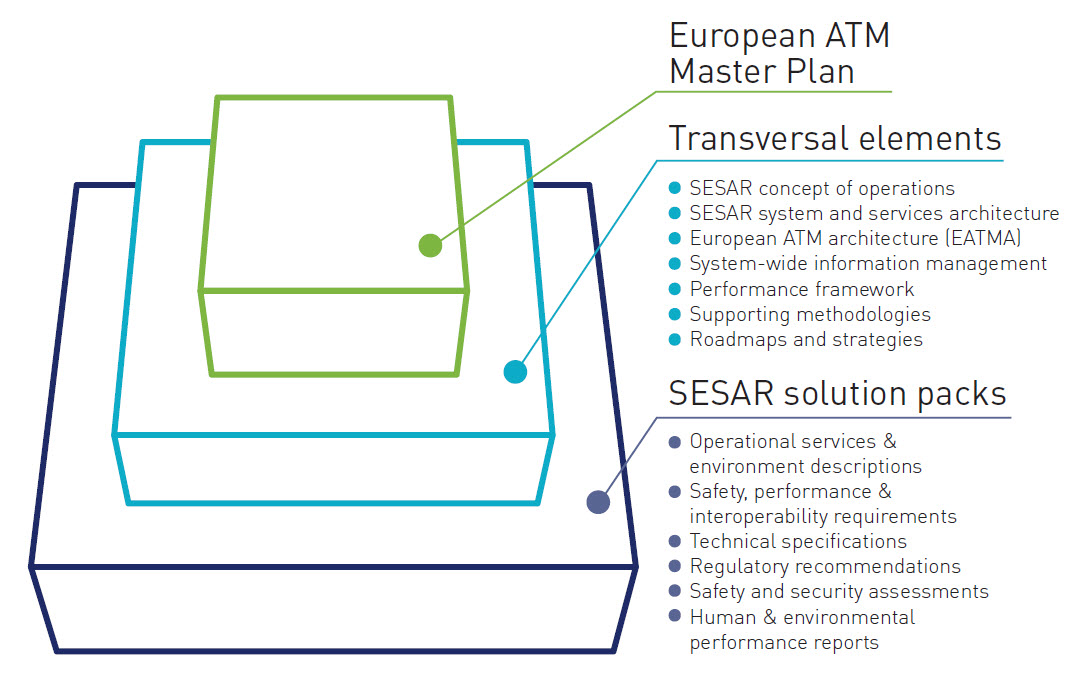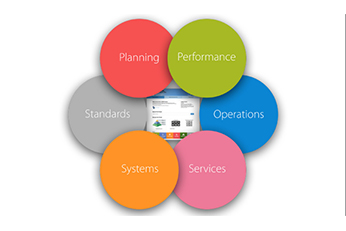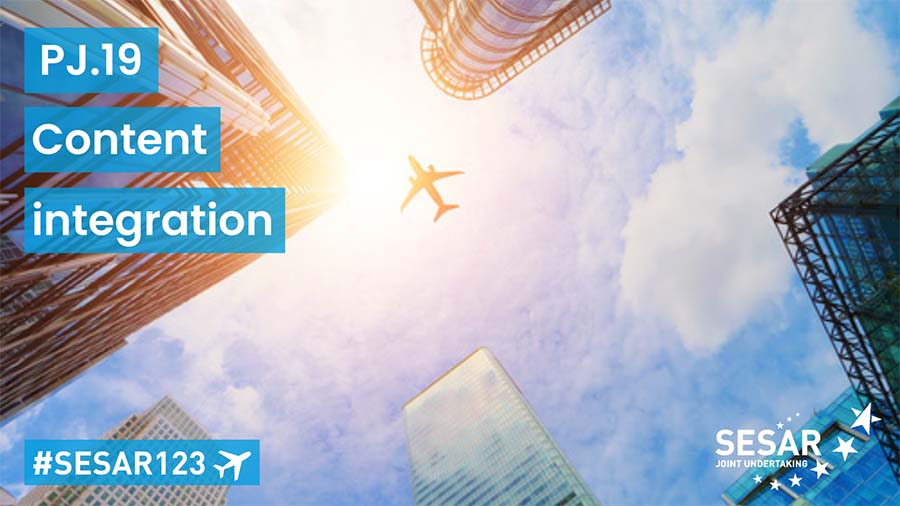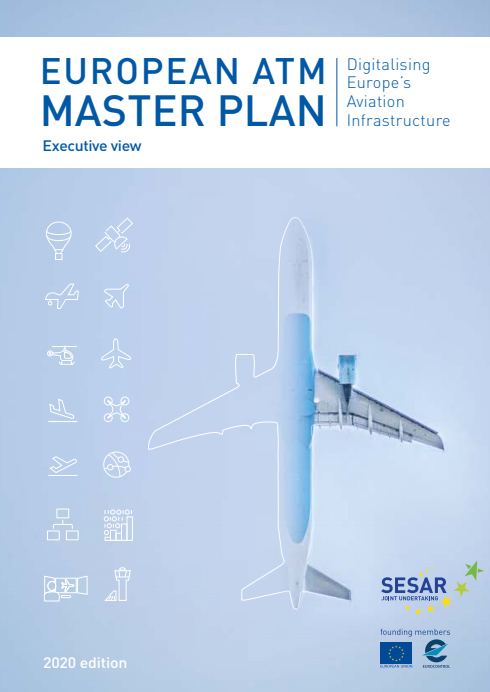SESAR transversal solutions
The operational and technical SESAR Solutions are very much the end-product of the SESAR research and innovation pipeline. However these solutions would not see the light of day if it were not for a number of important transversal elements and activities that support and frame the operational and technological work. These transversal elements, working in the shadow of the programme, ensure that the end-products fully fit with the SESAR vision and meet the necessary criteria, whether it has to do with the system, service and operational architectures, the key performance ambitions or the required cost benefit analysis and business case. These elements are complementary to one another and are regularly reviewed to ensure alignment with the SESAR vision.
Latest news
Seeing the big picture

European ATM Master Plan
Set within the framework of the Single European Sky (SES), the Master Plan is the European planning tool for defining ATM modernisation priorities and ensuring SESAR Solutions become a reality. Both pragmatic and ambitious in its design, the Plan provides a high-level view of what is needed in order to deliver a high-performing aviation system for Europe. It also sets the framework for the related development and deployment activities, thereby ensuring that all phases of the SESAR lifecycle remain connected. The content of the Master Plan is structured into three levels, allowing stakeholders to view the information that is most relevant for them whether they are executives, planners or those implementing the plan.
SESAR Concept of Operations
The Master Plan is supported by the SESAR Concept of Operations (CONOPS). It describes the operational target, namely to move ATM towards business or mission trajectory-based operations. The CONOPS allows all those in ATM, from the civil and military airspace users and service providers, to airports and the manufacturing industry to gain common understanding of the system and clear view of the phases to achieve the concept target. The SESAR CONOPS, which has been adapted for Europe from the ICAO Global Air Traffic Management Operational Concept is an important reference for global interoperability and harmonisation.
SESAR system and services architecture
To meet the operational needs described in the CONOPs, SESAR has developed and described an overall technical architecture of the ATM system that highlights interconnectivity between the various technical systems through system-wide information management (SWIM) and message exchange interfaces. This is captured in the architecture description document, which is the entry point to more detailed architectural information hosted in the European ATM architecture (EATMA) framework (see below).
European ATM Architecture (EATMA)
The EATMA is a repository of content and programme-related information that provides the structure to the work of the 300 projects that have made up the first SESAR R&I activities (SESAR 1). In doing so, the EATMA ensures a coherent architecture framework for developing interoperable solutions, as well as for identifying gaps or duplication of technical system work between projects. As a framework, the EATMA federates the performance framework as well as operational, systems and service architectures. The EATMA is accessible through the ATM Master Plan portal that captures, maintains, validates and reports on architecture-related content.
Information exchange at your service
SWIM represents a complete paradigm change in how information is managed and shared along its full lifecycle and across the whole European ATM system. Building on the best practices from different information communities, the aim of SWIM is to provide relevant and commonly understandable information to the users. This means making the right air traffic management information available at the right time to aircraft, airports, air traffic controllers, and air navigation service providers, airline operation centres, military operation centres, ground vehicles, flow management centres, and weather service providers. The implementation of the SWIM concept will enable direct ATM business benefits to be generated by assuring the provision of commonly understood quality information. SWIM will result in a more cost and time efficient exchange of information between providers and users.
The SWIM Framework will be an input to the SWIM standardisation activities in the deployment context. Furthermore, it will also be an input to the work on SWIM within the context of ICAO. (e.g. ICAO Doc 10039). A key aspect of SWIM is the capability of aviation stakeholder organisations to interoperate through its systems. In this context standards and related guidance play a prominent role as the SWIM definition indicates. These standards cover the areas of information, services, technical infrastructure, and governance.
SWIM Framework solution consists of the following documentation:
08.01.01-D47 SWIM Governance Structure
08.01.01-D49 SWIM Compliance Framework
08.01.01-D49 SWIM Compliance Framework Criteria Template
08.01.01-D53 SWIM Registry ConOps
08.01.03-D48 AIRM Foundation Rulebook v4.1.0
08.03.10-D45 ISRM Foundation v00.08.00;
Making the case
Meeting the performance ambitions
Performance is the heart of the Single European Sky and therefore SESAR’s work. It is no surprise then that the SESAR JU programme has integrated a framework to measure the performance of SESAR Solutions and aggregate the results to the level of the Master Plan. This approach means that at the very outset, SESAR Solutions are designed with a range of performances ambitions in mind (operational and cost efficiency, capacity, safety, environment, security), aimed at contributing in a measurable way to reaching the SES performance targets and, in the long term, the SES high-level goals. The framework and process also allow for the traceability of performance throughout the development of the solutions until their delivery. Regular performance assessments are made providing the detailed calculations, assumptions and gap analysis for SESAR Solutions. The bottom-up results stemming from individual analysis on the different Solutions are then consolidated at a higher level to provide a holistic view of the performance of SESAR and to identify possible performance gaps.
Supporting methodologies
Supporting methodologies form part of the backbone of any R&I programme, since they ensure that a common approach to testing and analysis. A range of methodologies has been developed to support assessments of solutions. These assessments provide input to cost benefit analysis and the overall business case of a solution. They also allow for forward and backward traceability between R&I and the High Level Goals of the Single European Sky.
Safety: enables safety assessments to be carried out across the programme in a systematic way. The methodology framework is also validated by the European Aviation Safety Agency (EASA). It is documented in the safety reference material (SRM) and is based on a rigorous requirements-engineering (RE) approach.
Download the Safety Reference Material guidance document
Download the Guidance to Apply the SESAR2020 Safety Reference Material
Security: provides a holistic approach to assess ATM security, addressing personnel, procedures and the physical infrastructure, as well as information and communications technology (ICT) systems. The approach is documented in the SESAR ATM security risk assessment methodology (SecRAM) and can be applied in a tailored manner to the projects developing solutions. The methodology consists of several catalogues containing security assets (information and services) and controls that can be selected to mitigate risks. In addition the methodology uses a specialised database in which to store results for analysis and to automatically generate reports.
Download the Security assessment guidance document
Human performance: ensures that human performance-related aspects are systematically identified and managed during the definition, development and validation of solutions. The methodology provides projects with a framework in which to assess whether a solution will contribute to expected human performance benefits and is within the scope of human capabilities and limitations.
Download the Human performance assessment guidance document
Environment: offers common approach to making the environmental impact assessments of solutions. The process, captured in a document called environment reference material (ERM), is derived from a mapping onto the SESAR validation framework of the globally-recognised process from ICAO. The methodology provides guidance at each step of the validation process of a particular solution, indicating, for instance, types of environmental impact that should be assessed, and when and how they should be assessed. The methodology includes tools for assessing a solution’s impact in terms of noise and fuel and emissions (IMPACT); local as well as global fuel and emissions (AEM); airport fuel and emissions and dispersion (Open-ALAQS); and for vertical flight path analysis (V-PAT). It should be noted that these tools have also been developed to be used for the research and future deployment phase of SESAR. The methodology also contains an appendix describing the assessment of fuel efficiency based on aircraft-derived data from flight trials, one of the main validation techniques used by the SESAR R&I programme.
Download the Environment assessment guidance document
Cost benefit analysis (CBA) and business case development: provides an approach and common guidance to structure, organise and validate the many contributions stemming from the active involvement and support of all ATM stakeholder groups in defining the economic, financial and business impact of SESAR. The reference material goes beyond strict CBA models and includes also the method to assess costs and to identify, structure and monetise the benefits in the validation activities. The solution integrates several different models including scheduled airlines, business aviation, general aviation, rotorcraft, ANSP and airports as well as a cost model for the military.




